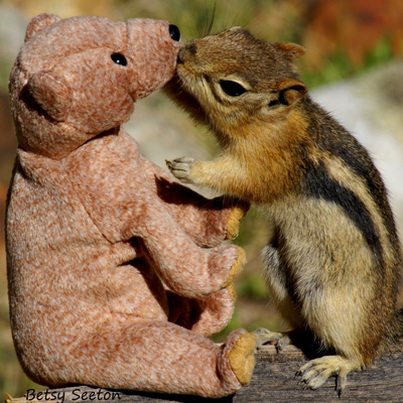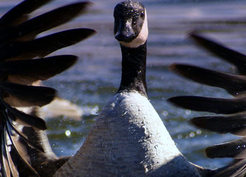|
"If we are to teach compassion for all life
in this world, and if we are to carry on a real campaign against cruelty, and against the destruction of our environment, we have to begin with reaching children." ~ Betsy Seeton |
. |
|
Click here or on the image below to go to over a hundred photos of bees in their natural habitat. My book, BEE INSPIRED, will be out in November. It's a photo story of the healing power of bees. WORKER BEES What you see here in most of these photos are worker bees. They are females that are not sexually developed. Females number in the tens of thousands per hive whereas there are only several hundred males per hive known as drones. They don't gather pollen or help out in the hive. Drones do very little except mate with the queen a single time, after which they promptly die. Their sexual organ contains barbs much the same way the female stinger does and after the drone disengages the queen his organs are ripped from his body resulting in death. DRONES GET THE HEAVE-HO In the fall, drones are expelled from the hive because they offer no contribution and would only make it harder for the others to survive because they're in essence dead weight during the cold, winter months.  March 11, 2011 - by Betsy Seeton This photo might be a shot of a drone in flight. From what I read, and using the chart directly below, drones lack the orange tones on the abdomen and instead are predominantly black. There's one more photo toward the bottom of this page that I also suspect is a drone.  Pollen coming in March 11, 2011 - by Betsy Seeton POLLEN GATHERERS I've been watching the worker bees come and go from the hive and many bring loads of pollen back with them. I don't know where they get all the pollen in the middle of winter. There are no flowers around that I can see. WING FLAPPERS I've also observed them flapping their wings and wondered why. I discovered it's to keep the hive clean by circulating the air and more importantly to regulate the hive's temperature. Fanning is also used to evaporate water which aids in turning nectar into honey. From what I've seen over the past three weeks, this hive is very healthy. The worker bees are steadily bringing lots of pollen. I'll watch them land at the entrance, their hind legs full of pollen, and then they quickly waddle their way on in and down into the hive out of sight. Notice the photo below where the pollen is bright orange instead of cream colored. This means a new flower is blooming.  Taken March 14, 2011 - by B.Seeton "Subtle flavor and color differences in honey depend on floral varieties and local weather. In the U.S., there are over 300 sources of honey, including popular varieties like clover, alfalfa, buckwheat, and orange blossom, and regional specialties like fireweed, tupelo, and macadamia nut honey." Source: http://ask.yahoo.com/20021203.html How well I relate to this quote .... A lover of nature once said, "Happy he who, resting in the grass in the evening close to an apiary, in the company of his dog, heard the song of the bees blending itself with the chirping of the crickets, with the sound of the wind in the trees, the twinkling of the stars and the slow march of the clouds!" Source: Beekeeping For All by Abee Warre [FOR IMAGES OF THE BEES IN APRIL CLICK HERE!]  I think this is the queen. Taken April 5th - by Betsy Seeton. THE QUEEN "A two-day-old larva is selected by the workers to be reared as the queen. She will emerge from her cell 11 days later to mate in flight with approximately 18 drone (male) bees. During this mating, she receives several million sperm cells, which last her entire life span of nearly two years or longer. The queen starts to lay eggs about 10 days after mating. A productive queen can lay 3,000 eggs in a single day." source: http://www.beeman.ca/id18.html "The queen's job is simple—laying the eggs that will spawn the hive's next generation of bees. There is usually only a single queen in a hive. If the queen dies, workers will create a new queen by feeding one of the worker females a special diet of a food called "royal jelly." This elixir enables the worker to develop into a fertile queen. Queens also regulate the hive's activities by producing chemicals that guide the behavior of the other bees. Male bees are called drones—the third class of honeybee. Several hundred drones live in each hive during the spring and summer, but they are expelled for the winter months when the hive goes into a lean survival mode. Bees live on stored honey and pollen all winter, and cluster into a ball to conserve warmth. Larvae are fed from the stores during this season and, by spring, the hive is swarming with a new generation of bees." Source: National Geographic THE IMPORTANCE OF POLLINATION Insects such as bees, moths and hoverflies pollinate around a third of the agricultural crops grown around the world. Pollinators are also crucial for the quality of fruits and vegetables. Perfectly shaped strawberries, for example, are created only if every single ovary has been pollinated by an insect. And the number of seeds in a pumpkin depends on the number of species of insects that have pollinated the plants. "If you have 10 pollinators, you'll get more seeds in the pumpkin than you would have gotten if you have just one pollinator," said Giles Budge of the Food and Environment Research Agency. "It is important to have that diversity in a pollinating population." Source: http://www.guardian.co.uk by Alok Jha GUARD BEES (aka "the bouncers") At the entrance to the hive, I often see the "guard" bees. These are the female bees that are 18 days old. How scientists have determined this with such precision is amazing, but no more so than the fact that bees adhere to such strict schedules from one generation to the next. I wonder if it ever varies? At any rate, their sting is fully developed at this stage. The guard's job is to sniff out intruders and do whatever it takes to keep out bees who don't belong to the colony. These guard bees can literally smell if a bee is not a local resident and they will fight to the death to do their 'bouncer' job. When guard bees are 21 days old they begin to fly and leave the hive with different duties for the colony.  Lone 'guard' bee at the entrance to the hive - by Betsy Seeton I shot this photo on March 5th when the temperature dropped into the low 40's. The hive was almost completely quiet with only an occasional bee flying in and out, and a very slow moving "guard" bee every once in awhile crawling up from below the entrance to see what was going on and then crawling back down into the hive leaving the entrance unguarded. This is when I can get inches from the hive and really examine the hexagons and work.  This is at the entrance of the hive and my guess is that this could be a skirmish between a "guard" bee and a hive crasher! But I'm only guessing .... STRAIGHT FROM http://www.pa.msu.edu/sciencet/ask_st/073097.html : "Honeybees use nectar to make honey. Nectar is almost 80% water with some complex sugars. In fact, if you have ever pulled a honeysuckle blossom out of its stem, nectar is the clear liquid that drops from the end of the blossom. In North America, bees get nectar from flowers like clovers, dandelions, berry bushes and fruit tree blossoms. They use their long, tube-like tongues like straws to suck the nectar out of the flowers and they store it in their "honey stomachs". Bees actually have two stomachs, their honey stomach which they use like a nectar backpack and their regular stomach. The honey stomach holds almost 70 mg of nectar and when full, it weighs almost as much as the bee does. Honeybees must visit between 100 and 1500 flowers in order to fill their honey stomachs. The honeybees return to the hive and pass the nectar onto other worker bees."  Transferring nectar from a worker bee to a house bee - by Betsy Seeton NECTAR TRANSFER This is a shot inside the tree on the hive where you can spot a red tongue going between two bees. What you're seeing is nectar being sucked from a worker bee into the mouth of the house bee. These house bees "chew" the nectar for about half an hour. During this time, enzymes are breaking the complex sugars in the nectar into simple sugars so that it is both more digestible for the bees and less likely to be attacked by bacteria while it is stored within the hive.  Inside the hive - by Betsy Seeton "The bees then spread the nectar throughout the honeycombs where water evaporates from it, making it a thicker syrup. The bees make the nectar dry even faster by fanning it with their wings. Once the honey is gooey enough, the bees seal off the cell of the honeycomb with a plug of wax. The honey is stored until it is eaten. In one year, a colony of bees eats between 120 and 200 pounds of honey." Source: www.pa.msu.edu/sciencet/ask_ st/073097.html  March 10, 2011 - by Betsy Seeton In this photo you can sort of see both sets of wings on the bee in flight. The larger pair of wings are the forewings and the smaller set are the hindwings.  March 10, 2011 - by Betsy Seeton Read: WHERE HAVE ALL THE BEES GONE? In China the problem is so bad that humans are taking over the job of bees and hand pollinating! Einstein supposedly said if bees were to disappear from the surface of the earth humanity would have no more than four years to live – whereas if we were to disappear, the rest of the planet would carry on just fine. Others argue that Einstein never said this, but whether he said it or not, it got people's attention. And the fact is that the loss of bees will have drastic consequences for the human race. Another fact is that bee populations are diminishing at alarmingly high rates. Bee decline could be down due to chemical cocktail interfering with their brains. Read Article  by Betsy Seeton Click for another very good article about our vanishing bee population .... below is an excerpt: From the 2 May 2010 Observer (UK): "The number of managed honeybee colonies in the US fell by 33.8% last winter, according to the annual survey by the Apiary Inspectors of America and the US government's Agricultural Research Service (ARS). The collapse in the global honeybee population is a major threat to crops. It is estimated that a third of everything we eat depends upon honeybee pollination, which means that bees contribute some £26 bn [over $42 bn] to the global economy…US scientists at the ARS have found 121 different pesticides in samples of bees, wax and pollen, lending credence to the notion that pesticides are a key problem. (Source: http://www.mvtimes.com/marthas-vineyard/article.php?id=4587) You can also read about the decline in the bee population in the UK. An estimated 17% of bees were lost in 2010. An interesting short read is DANCING BEES SPEAK IN CODE. Here's an excerpt: "Bees outfitted with tracking devices responded to the wiggling of one of their fellow foragers, who had just returned to the hive from some newfound bee vittles.? The dance, which is performed on one of the honeycomb walls, is not an exact language, but it gets the job done. The central element of the choreography is a shimmy, or waggle, along a straight line. For emphasis, the bee repeats this move several times by circling around in a figure-8 pattern. The angle that the shimmy makes in relation to an imaginary vertical line is the direction to the food source with respect to the sun. For example, a waggle dance pointing towards 3 o'clock is bee talk for: "Hey, there's food 90 degrees to the right of the Sun." Read full article These bee swarm photos were taken on September 1, 2007, which is the first day of spring in Australia. They were taken in the suburb of Canberra, Australia. The wonderful photographer, Alan (aka Al) Hanbridge, a friend of mine I met on RedBubble's art site, wrote that when the bees left the branch it shot straight back up to where it belonged! Swarming is the natural means of reproduction of honey bee colonies. A new honey bee colony is formed when the queen bee leaves the colony with a large group of worker bees, a process called swarming. In the prime swarm, about 60% of the worker bees leave the original hive location with the old queen. This swarm can contain thousands to tens of thousands of bees. Swarming is mainly a spring phenomenon, usually within a two- or three-week period depending on the locale, but occasional swarms can happen throughout the producing season. Secondary afterswarms may happen but are rare. Afterswarms are usually smaller and are accompanied by one or more virgin queens. Sometimes abeehive will swarm in succession until it is almost totally depleted of workers. Source: wikipedia by Marion Ellis, Extension Apiculture Specialist Source: http://entomology.unl.edu/beekpg/beeswarm.shtml 1. What is a honey bee swarm? Honey bee swarms are a favorite topic of people who make horror movies. Actually, they are one of the most beautiful and interesting phenomena in nature. A swarm starting to issue is a thrilling sight. A swarm may contain from 1,500 to 30,000 bees including, workers, drones, and a queen. Swarming is an instinctive part of the annual life cycle of a honey bee colony. It provides a mechanism for the colony to reproduce itself. 2. What makes a honey bee colony swarm? Overcrowding and congestion in the nest are factors which predispose colonies to swarm. The presence of an old queen and a mild winter also contribute to the development of the swarming impulse. Swarming can be controlled by a skilled beekeeper; however, not all colonies live in hives and have a human caretaker. 3. When do honey bees swarm? The tendency to swarm is usually greatest when bees increase their population rapidly in late spring and early summer. In Nebraska, this would be in May and June. READ 4 THROUGH 9 HERE
3 Comments
4/10/2011 06:10:50
Website is a landing page only. See Bocage Honey on FaceBook.
Reply
Al Hanbridge
4/10/2011 17:11:18
Hi Betsy!
Reply
1/20/2012 19:27:49
Bees play an important role in pollinating flowering plants, and are the major type of pollinator in ecosystems that contain flowering plants. Bees either focus on gathering nectar or on gathering pollen depending on demand, especially in social species. Bees gathering nectar may accomplish pollination, but bees that are deliberately gathering pollen are more efficient pollinators.
Reply
Your comment will be posted after it is approved.
Leave a Reply. |
By Betsy Seeton
Loading
"If we are to teach compassion for all life in this world, and if we are to carry on a real campaign against cruelty, and against the destruction of our
environment, we have to begin with reaching children." -- Betsy Seeton FOR ALL
|

















































 RSS Feed
RSS Feed
